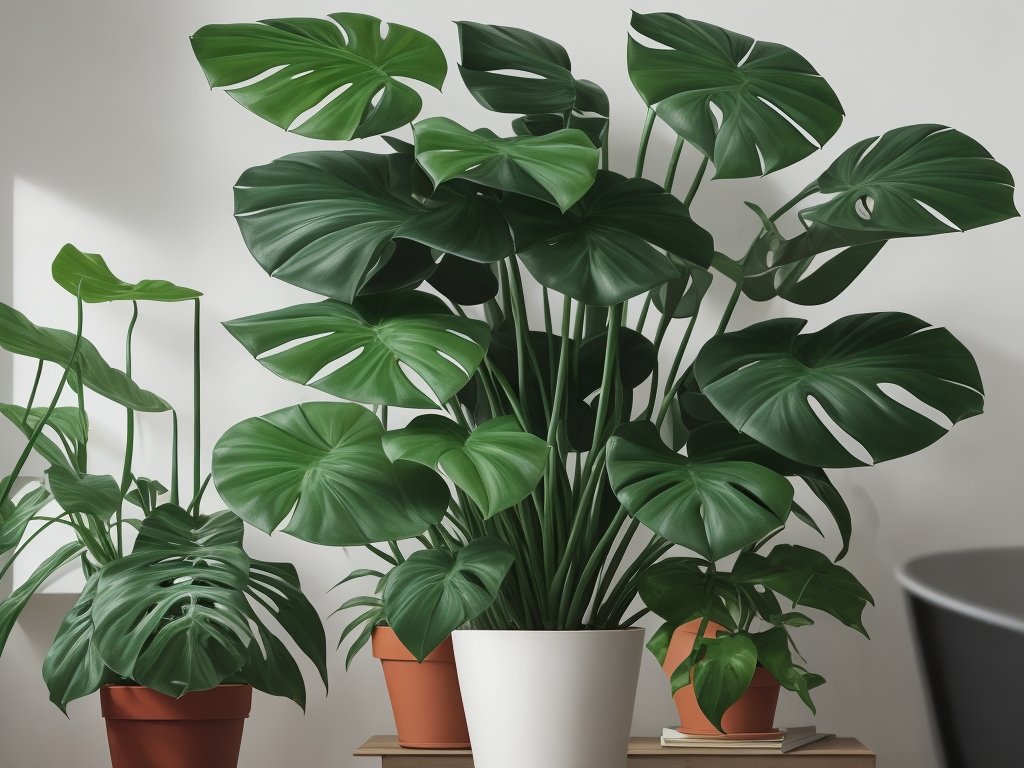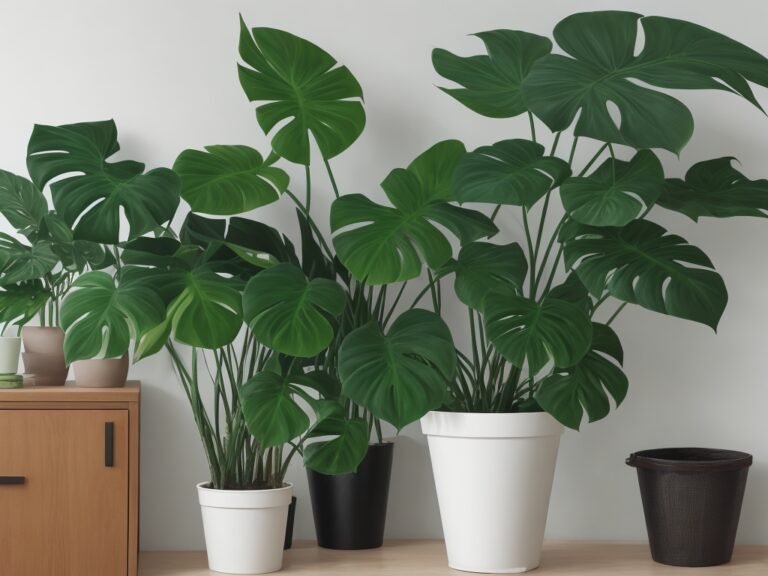Signs Your Monstera Plant Is Getting Too Much Sun – Protect your leafy friend!
Key Takeaways:
- Yellowing or browning leaves can indicate your Monstera plant is receiving too much sun.
- Leaf drooping or wilting can be a sign of excessive sunlight exposure.
- Sunburned or crispy leaf edges may indicate that your Monstera plant is getting too much direct sunlight.
- If your Monstera’s growth is stunted or it is not producing new leaves, it may be getting too much sun.
Have you ever wondered if your Monstera plant is getting too much sunlight? Well, you’re not alone! As a plant lover myself, I understand the struggles of finding the perfect balance for our green companions.
In this article, I’ll dive into the signs your Monstera plant may be receiving too much sun.
From brown or yellow leaves to stunted growth, these indicators can help you diagnose the issue and take action. But don’t worry, I’ve got you covered with tips on how to protect your Monstera from excessive sunlight.
Let’s ensure your plant thrives and stays happy and healthy!
| Signs of Too Much Sun | Description |
|---|---|
| 1. Fading Leaves | The vibrant green color of the leaves may start to fade and appear washed out. |
| 2. Yellow or Brown Spots | You may notice yellow or brown spots on the leaves, which can indicate sunburn or damage. |
| 3. Curling Leaves | The leaves may start to curl or wilt, which is a sign of dehydration due to excessive sun exposure. |
| 4. Leaf Burn or Scorching | Extreme sun exposure can cause the edges or tips of the leaves to get burned or scorched. |
| 5. Stunted Growth | If your Monstera plant is not receiving enough shade, it may struggle to grow properly and appear stunted. |
What is a Monstera plant?
A Monstera plant is a popular houseplant known for its large, glossy leaves and unique air-purifying qualities. It adds a touch of tropical vibes to any space.
Description and characteristics of Monstera plants
Monstera plants, also known as Swiss cheese plants, are popular houseplants known for their large, glossy, and perforated leaves.
They have a tropical and exotic appearance, making them a favorite among plant enthusiasts.
Monstera plants are vine-like in nature and can climb or trail, adding a touch of greenery to any space.
They are relatively low-maintenance and can thrive in a variety of conditions.
Their unique leaves and easy care requirements make Monstera plants a great addition to any indoor garden.

Popular varieties of Monstera plants
Popular varieties of Monstera plants include Monstera deliciosa, also known as the Swiss cheese plant or fruit salad plant, which has large, perforated leaves. Another popular variety is Monstera adansonii, commonly called the Swiss cheese vine, with smaller leaves and more intricate perforations.
Monstera obliqua, often called the Swiss cheese plant’s rare cousin, is another sought-after variety due to its delicate and fenestrated leaves.
The importance of sunlight for Monstera plants
Sunlight is essential for the healthy growth and wellbeing of Monstera plants.
How sunlight affects Monstera plant growth and health
Sunlight is essential for the growth and health of Monstera plants. It provides the energy needed for photosynthesis, the process by which plants convert light into food.
Adequate sunlight promotes strong and lush foliage, while a lack of sunlight can lead to weak and spindly growth.
However, too much direct sunlight can cause leaf burn and damage. Finding the right balance of sunlight is important for optimal Monstera plant growth and health.
The ideal amount of sunlight for Monstera plants
The ideal amount of sunlight for Monstera plants is bright, indirect light.
They thrive in medium to bright light conditions, but direct sunlight should be avoided as it can cause their leaves to burn.
Place them near a window with filtered light or use curtains to diffuse the sun’s rays.

Signs of Monstera plant getting too much sun
If your Monstera plant has brown or yellow leaves, it may be a sign that it is getting too much sun.
Leaf burn or scorched edges can also indicate excessive sunlight.
Brown or yellow leaves
Brown or yellow leaves on a Monstera plant indicate that it is getting too much sun.
This can lead to leaf burn, wilting, and stunted growth.
Adjusting the plant’s location, using sheer curtains or shade props, or bringing it indoors temporarily can help protect it from excessive sunlight.

Leaf burn or scorched edges
Leaf burn or scorched edges are a common sign that your Monstera plant is getting too much sun. The intense sunlight can cause the leaves to develop brown or yellow patches, giving them a burnt appearance.
To protect your plant, adjust its location to a spot with less direct sunlight or provide shade using curtains, blinds, or props.
Wilting or drooping leaves
Wilting or drooping leaves are a common sign that your Monstera plant is getting too much sun.
When exposed to excessive sunlight, the leaves can become dehydrated and lose their turgidity, causing them to wilt or droop.
This is the plant’s way of protecting itself from further sun damage.
To protect your Monstera, adjust its location to provide shade or use props to create shade.
Stunted growth or smaller leaves
Stunted growth or smaller leaves in Monstera plants can be a sign of excessive sunlight.
When the plant receives too much sun, it can cause the leaves to become smaller in size and hinder their growth.
Providing the right amount of shade and adjusting the plant’s location can help protect it from too much sun exposure.
How to protect your Monstera plant from excessive sunlight
Protect your Monstera plant from excessive sunlight by adjusting its location and finding a spot with indirect light.
Adjusting the plant’s location
To protect your Monstera plant from excessive sunlight, adjust its location to a spot that receives indirect or filtered light.
Move it away from windows or direct sunlight.
You can place it in a room with bright, indirect light or use sheer curtains or blinds to filter the sunlight.
Keep an eye on the plant’s response and adjust as needed.
Using sheer curtains or blinds
Using sheer curtains or blinds can help protect your Monstera plant from excessive sunlight. These window coverings allow some light to filter through while reducing the intensity and directness of the sun’s rays.
Install them in the windows where your plant is located to provide a diffused and gentle light environment.
Creating shade using props or structures
To create shade for your Monstera plant, you can use props or structures. Here are some ideas:
- Use a sheer curtain or shade cloth: Hang a sheer curtain or shade cloth near the window where your plant is located. This will help filter out excessive sunlight while still allowing some light to pass through.
- Place the plant near larger plants or furniture: Position your Monstera near larger plants or furniture that can provide shade. This will help block direct sunlight and create a shaded area for your plant.
- Use a plant stand or shelf: Elevating your Monstera on a plant stand or shelf can help reduce exposure to direct sunlight. Position it in a shady area or create shade by placing other plants or objects around it.
- Install a window awning or blinds: If your Monstera is near a window, consider installing an awning or using blinds to regulate the amount of sunlight it receives. Adjust the awning or blinds to create shade during the sunniest parts of the day.
Remember, it’s important to find a balance between providing enough shade and ensuring your Monstera still receives adequate light for its growth.
Bringing the Monstera indoors temporarily
To bring your Monstera indoors temporarily, find a spot with bright, indirect light.
Avoid placing it directly in front of a window to prevent sunburn.
Make sure the room temperature is suitable for your plant, ideally between 65-85°F.
Keep the humidity levels high by misting the leaves regularly or using a humidifier.
Remember to acclimate your Monstera to its new indoor environment gradually to prevent shock.
Frequently Asked Questions
Can Monstera plants tolerate direct sunlight?
Yes, Monstera plants can tolerate direct sunlight, but they prefer bright, indirect light.
Direct sunlight can cause leaf burn and damage their foliage.
It’s best to place your Monstera in a spot with bright, filtered light to keep them healthy and happy.
Can Monstera plants recover from sun damage?
Yes, Monstera plants can recover from sun damage if given the proper care and conditions. It’s important to move the plant to a shadier spot, trim off any damaged leaves, and ensure it receives the right amount of water and humidity.
With time and care, the plant can bounce back.
Can Monstera plants survive in low light conditions?
Yes, Monstera plants can survive in low light conditions to some extent. However, they will not thrive or grow as vigorously as they would in brighter light.
In low light, the growth may be slower, and the leaves may appear smaller and less vibrant.
It’s important to provide them with some indirect or filtered light to ensure their overall health and well-being. Additionally, avoid placing them in completely dark spaces as they need some light to carry out photosynthesis.
How often should I water my Monstera plant?
Water your Monstera plant every 1-2 weeks, or when the top inch of soil feels dry. Adjust watering frequency based on the season or environmental conditions.
It’s important to provide enough moisture without overwatering, as excessive water can lead to root rot.
Monitor the soil moisture and let the plant’s needs guide your watering schedule.
Final Verdict
It is crucial to pay attention to the amount of sunlight your Monstera plant receives to ensure its optimal growth and health. Signs of too much sun exposure include brown or yellow leaves, leaf burn or scorched edges, wilting or drooping leaves, and stunted growth.
To protect your Monstera plant, adjust its location, use sheer curtains or blinds, create shade with props or structures, or temporarily bring it indoors.
Remember to strike a balance between sunlight and shade to provide the ideal conditions for your Monstera’s well-being.






